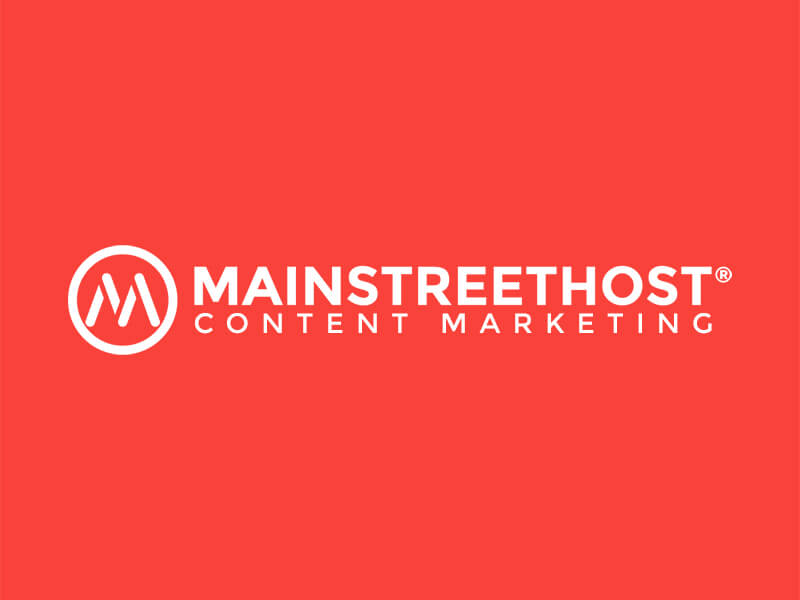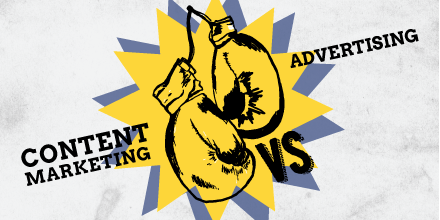I can’t make this decision for you, but I would like you to consider this:
Where advertising seeks to create a problem, content marketing seeks to solve problems.
Do you want to create more problems and add to the interruption that traditional advertising has become (sigh), or would you like to join us digital marketers on a quest to help people through inbound marketing?
Ultimately, the choice is yours. I urge you to think first of your audience. What do they want? Are they tired of being interrupted? Would they prefer solution-based marketing?
You tell me.
Pros and Cons of Traditional Advertising
As a society, we’re more connected than ever before (I know, I know, I’ve said this before, but it’s so true). And with that connection comes a constant stream of disruption. While the disruption of being connected can be an endless list of things (sending emails, texting, scrolling through social media, taking selfies, etc.), in the world of marketing, sales-y marketing and advertising campaigns have become disruptive.
At one time, sales-y advertising worked, and sometimes it still does. However, the increasing amount of information thrown at us on a day-to-day minute-to-minute basis is OUTRAGEOUS. Yes, I said it. The amount of information we are constantly bombarded with is INSANE. (I often wonder what the world would be like without the Internet, and then I realize I would be jobless! Alas, that’s a discussion for another time.)
With this incessant inundation of information, we tend to ignore, and in extreme cases abhor advertising attempts. Instead, we seek out answers to our questions and issues through videos, blog posts, ebooks, social media posts, and other resources that provide us the information we seek, without shoving a product down our throats.
I realize that last sentence was a bit of an exaggeration, but for some, the disruption that advertising has become is real. I say this with a heavy heart because I’m a true believer that there will always be a place for traditional advertising, just not in the traditional sense. Advertising has and will continue to become less about the product and more about the people using the product.
Despite the changing times, advertising continues to have a very real place in the marketing of products and services. Through advertising, you’re able to identify where you want your ads to appear. Whether you’re placing them in niche magazines, or on particular television networks at specific times, you have some control over who sees them – initially, anyways. Here’s the catch: advertising can come with a steep price tag depending on the placement of the ad, and that doesn’t even include production.
Depending on the size of your business or budget, one campaign could be it for the year – we can’t all place a Super Bowl ad! This could limit your reach, and if the campaign isn’t received as well as you thought, then what? You just spent your budget and you have no money left. Alternatively, that one campaign could be a hit and generate more ROI than you ever imagined. You really never know.
If you haven’t noticed by now, there are many pros and cons of traditional advertising. For every pro, there is generally a con to counter, and vice versa. Ultimately, there’s no cut and dry answer on whether advertising is your best bet.
Here’s My Advice: Research, Research, Research!
Find out where your audience is and what they like to see – are they watching a lot of television and reading magazines and newspapers for information? When you can identify what your audience craves and where they spend their time, you’ll have a better idea of where you should allocate your resources.
Pros and Cons of Content Marketing
Content marketing: it’s been around for quite some time, but has been gaining more steam over the past few years. If you’re not familiar with the term or concept, here’s a brief run-down of why content marketing is important.
As defined by The Content Marketing Institute, content marketing is “a marketing technique of creating and distributing valuable, relevant and consistent content to attract and acquire a clearly defined audience – with the objective of driving profitable customer action.”
The goals of content marketing will vary, but generally speaking, the ultimate goal is to sell something. This shouldn’t be your only goal, but I get it; as a business you want to make a profit. Content marketing can help you do this. However, it will take time and some strategic planning to help guide your audience through the sales funnel with your content marketing efforts.
One of the greatest things about content marketing is the variety of “mediums” considered to be content. Content can be anything including blog posts, website content, images, videos, social media posts, ebooks, SlideShares, presentations, infographics, etc. In this light, the possibilities of content marketing are nearly endless.
Content marketing is (or at least should be) much more subtle than advertising, which in my opinion is a pro. At its core, content marketing should educate, inform and entertain your audience. Within your efforts, you’ll want to create an “Oh By The Way” Moment – this is where the selling comes in.
This idea, which is so eloquently explained in NextView’s Content Marketing Growth Guide, (I highly recommend reading this guide) should be the drive behind your content efforts. This “moment” happens when your content addresses your audiences’ problems, answers their questions, or simply provides them with information, making it clear that YOU can provide the best answers and solutions through your products.
While subtlety works to build loyalty, content marketing is not without its challenges. As I mentioned above, the amount of information thrown at us on a minute-to-minute basis is quite astounding, and it makes it that much more difficult for people to sift through the garbage to find the treasures (which is what your content should be).
Competing on the Internet isn’t impossible, but you must make your efforts unique, memorable, consistent and valuable. Content marketing is tricky, and what works for one brand might not work for another. It not only takes time to create and distribute quality content, but it can also take a significant amount of time to see an ROI.
Compared to traditional advertising, content marketing is much more reasonably priced (with some exceptions, of course). What you spend on one advertising campaign and placement can be used to create a variety of content marketing campaigns. These campaigns are perfect for social media platforms including Facebook, Twitter, YouTube, Pinterest, Instagram, LinkedIn, etc.
And while the Internet and digital marketing continues to progress, there are still many people who have no idea what content marketing is and what it entails (just try telling someone you’re a content marketer, they’ll respond to you like this).
Only time will tell, but I’m inclined to think individuals and businesses will continue to warm up to the idea of content marketing. And with good reason too: content marketing is the future of marketing.
Getting Started with Content Marketing on a Shoestring Budget
Since content marketing and inbound marketing are the future of marketing, here’s some guidance on getting started with your content marketing efforts.
1. Research: Like all marketing initiatives, you’ll want to begin with some research. Some questions you should answer include:
a. Who is my target audience?
b. Where does my audience spend their time?
c. What kind of information does my audience seek?
d. What kind of content does my audience find entertaining?
e. Who are my competitors?
i. What are they doing?
ii. How is it working for them?
iii. How can I do it better?
2. Start small: When you have a limited budget, choose your content marketing endeavors carefully. To establish and reinforce your brand’s voice and personality, start by adding a blog to your website. Decide how often you can post and stick to that.
3. Get social: If you’re not already on social media, get on it! Figure out where (which platforms) your audience is present and start listening, responding and engaging with them. Share the content from your blog and see what types of content garner the most attention and results. This will help you determine what your audience likes, which will help determine the best type(s) of content to create.
4. Stay consistent: Whether you’re going to post daily, weekly or monthly, stay consistent! I’m a true believer in quality over quantity, and while you may see more results quicker with more content, if it’s not quality content, it could hurt you.
5. Track results: Google Analytics is a great resource to track the success of your blog posts, and you can even set it up to track social media conversions. The social platforms also have insights, which show what posts are most successful, how many clicks they receive, how many shares, etc.
6. Start thinking bigger: As you dive into content marketing with blogging and social media, start thinking of more in depth projects such as ebooks, infographics and videos. While these are more intensive, they’re valuable ways to attract visitors, leads, and social media enthusiasts. This content not only helps keep you in your customers’ minds, but it’s also great for remarketing purposes.
The Final Answer: Content Marketing or Advertising?
Unfortunately, I still can’t tell you whether you should invest in content marketing or advertising. That’s still a decision you’ll have to make for your business. Both have their pros and cons, as with anything in life.
However, if you’ve been investing in advertising and aren’t seeing the results you’d hoped for, you might want to try content marketing. Provide your audience with content they can use and share – it’ll only help grow your business. Alternatively, try a mix of content marketing and advertising. After all, you’ll never know what works best until you test it out!
Whichever route you choose, I advise that you start solving your audience’s problems, not creating them.




